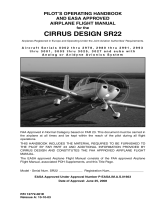
3rd Ed. Feb 15, 07 1-3
S–TEC
1.1 Document Organization
Section 1 Overview
Section 2 Pre-Flight Procedures
Section 3 In-Flight Procedures
Section 4 Operating Parameters
Section 5 Glossary
1.2 Purpose
This Pilot's Operating Handbook (POH) provides Pre-Flight and In-Flight
operating procedures for the S-TEC System Twenty / Thirty / Thirty ALT Autopilot
(AP).
Note:
This POH must be carried in the aircraft and made available to the pilot at all
times. It can only be used in conjunction with the Federal Aviation
Administration (FAA) approved Aircraft Flight Manual (AFM) or Aircraft Flight
Manual Supplement (AFMS). Refer to the applicable AFM or AFMS for
aircraft specific information, such as unique ground tests, limitations, and
emergency procedures.
Note:
The System Twenty / Thirty / Thirty ALT autopilot is a tool provided to aircraft
owners, that serves to assist them with cockpit workload management. The
ability of the autopilot to provide optimum assistance and performance is
directly proportional to the pilot's knowledge of its operating procedures.
Therefore, it is highly recommended that the pilot develop a thorough
understanding of the autopilot, its modes, and operating procedures in
Visual Meteorological Conditions (VMC), prior to using it under Instrument
Flight Rules (IFR).
1.3 General Control Theory
The System Twenty / Thirty / Thirty ALT is a rate based autopilot. When in control
of the roll axis, the autopilot senses turn rate, along with the non-rate quantities
of heading error and course deviation indication. When in control of the pitch
axis, the autopilot senses acceleration, along with the non-rate quantity of
altitude. These sensed data provide feedback to the autopilot, which processes
them in order to control the aircraft through the use of mechanisms coupled
to the control system. The roll servo is typically coupled to the ailerons, and
the pitch servo is coupled to the elevator.
The System Twenty controls only the roll axis.
The System Thirty controls both the roll axis and pitch axis. Activation of roll axis
control must always precede activation of pitch axis control.
The System Thirty ALT controls only the pitch axis.




















